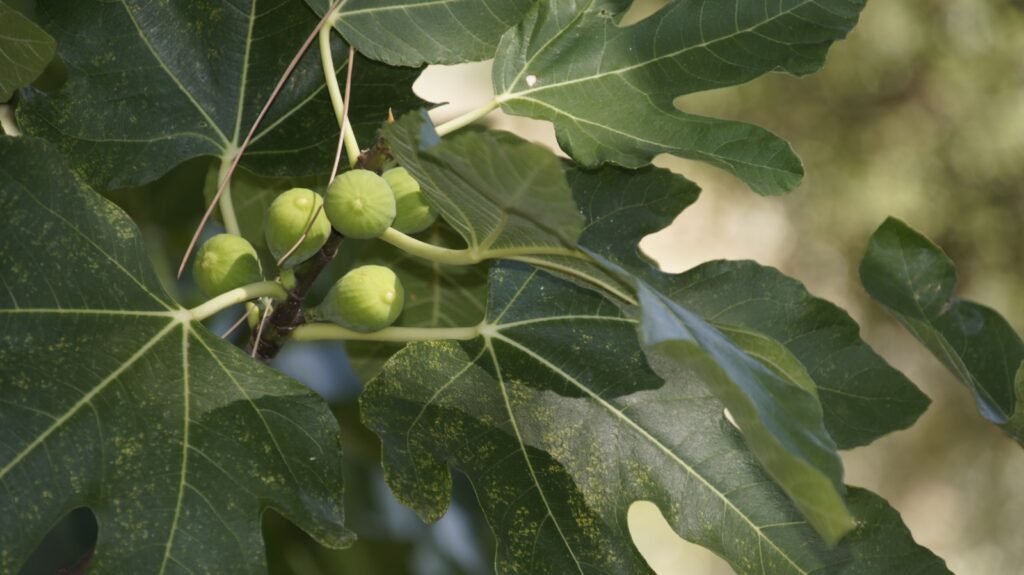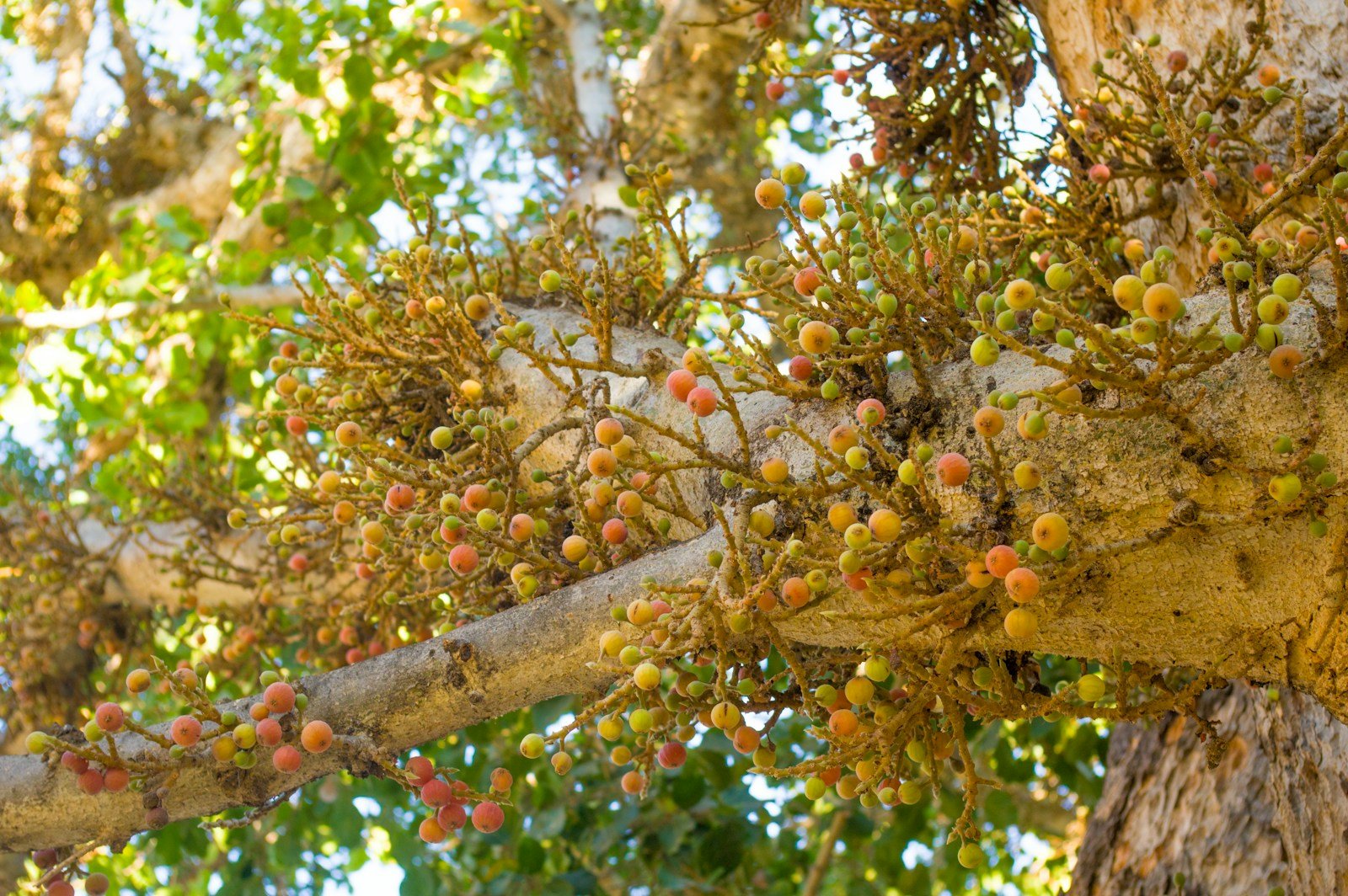The fig tree is a symbol of abundance and prosperity in the Bible. It represents spiritual significance and has deep meanings. From ancient times to Jesus’ teachings, the fig tree shows the connection between faith and spirituality.
But what does the fig tree mean in the Bible? What does a fig tree symbolize in the bible? How does it show the state of Israel and hint at a future spiritual awakening?
The Blessing of Figs in the Bible
The fig tree is very important in the Bible. It stands for prosperity, well-being, and security. It goes back to the garden of Eden, where Adam and Eve used fig leaves to cover themselves after they sinned.
In the Old Testament, the fig tree shows God’s covenant blessings. When God’s people follow His ways, they get rich and favored. But if they don’t, the fig tree’s lack or death means they face judgment and are rejected.
The Bible talks a lot about fig trees, often with vines. These trees grow and produce a lot of fruit easily. In Israel, some fig trees can even start bearing fruit in their first or second year.
The New Testament tells a story of Jesus cursing a fig tree. This story is in Matthew 21:18-22 and Mark 11:12-14. Jesus did this to show the importance of having spiritual fruit and being truly faithful, not just pretending to be.
The story of the fig tree teaches us a lesson. Just like a fig tree should have fruit, we should have spiritual fruit in our lives. This is true for both individuals and the nation of Israel. The fig tree symbolizes the need for spiritual awakening and true obedience.
Figs and fig trees get a lot of mentions in the Bible, with almost 200 references. Their importance is not just in their physical aspects but also in their symbolic meaning. Like the fig tree, we should aim to grow spiritually, bear fruit, and enjoy God’s faithful covenant blessings.

Fig Tree as a Metaphor for Israel
The fig tree is a powerful symbol in the Bible for the nation of Israel. It stands for both the physical and spiritual health of the nation. This symbol is deeply rooted in biblical stories, giving us deep insights into Israel’s history.
Israel’s bond with God is shown through the fig tree’s health. A healthy tree bears fruit, showing spiritual growth and faithfulness. Israel has times of being faithful and not faithful, just like the tree’s cycles.
In the Gospels of Matthew and Mark, Jesus curses a barren fig tree. This act shows judgment on Israel for not living up to God’s purpose for them.
Fig Tree Symbolism and Israel’s National Privileges
The Bible gives different trees symbolic meanings for Israel’s spiritual and national life. The vine stands for spiritual gifts, the olive tree for religious duties, and the fig tree for national identity.
The fig tree symbolizes Israel’s journey from Egypt to Canaan. Psalm 80:8-11 talks about the vine being brought out of Egypt and planted in Canaan. This shows Israel’s growth and flourishing like a fig tree.
Jesus also uses the fig tree in the New Testament. In the Parable of the “Barren Fig-tree,” he looks for fruit from the Jewish nation but finds none. Yet, the tree’s root is left, hinting at Israel’s possible revival.
Fig Tree Symbolism in Prophecies and Allegorical Usage
The fig tree symbol goes beyond Israel. It shows up in prophecies and allegories in the Bible. For example, Judges 9:10-11 uses it to represent righteous people.
At times, the fig tree stands for peace, beauty, service, decay, destruction, or famine. Proverbs 27:18 sees it as something needing work or service. Isaiah 34:4 uses it for decay, death, and destruction.
These examples show the fig tree’s wide range of meanings. It’s not just about Israel but also about other themes in the Bible.
The fig tree symbolizes Israel’s spiritual and national health deeply. Its health mirrors Israel’s bond with God. It reminds us of the need for righteousness and faithfulness. The fig tree’s symbolism is key to understanding God’s justice and authority.
The Symbolism of the Fig Tree in the New Testament
The fig tree is very important in the New Testament. Jesus used it to share deep messages. He talked about giving to others and our relationship with God.
Jesus met Nathanael under a fig tree and called him a “true Israelite” (John 1:47). This shows the fig tree’s link to faithful people. It’s like a sign of true faith in God’s chosen ones.
Also, Jesus used the fig tree to show what happens when we don’t produce spiritual fruit (Mark 11:12-14). He cursed a tree that had no fruit. This teaches us about the need to have spiritual fruit and the dangers of just going through the motions in our faith.
The fig tree also stands for understanding the signs of the times. In Matthew’s Gospel, Jesus says the fig tree’s leaves tell us when summer is near (Matthew 24:32-35). This means we should be alert and aware of God’s signs.
In the Book of Revelation, the fig tree symbolizes spiritual awakenings and seeing signs of the end times.
Figs in Israel Today
Israel’s Mediterranean climate makes it ideal for fig trees. These ancient trees are a big part of the country’s history. They still produce fruit, showing the deep meaning figs have in the Bible.
Fig trees can have three harvests a year, showing their strength and plenty. In Israel, the first harvest comes in May with the breba figs. These fruits grow on last year’s wood and signal the start of the harvest season.
The Breba Figs: Spring Awakening
May brings the first signs of figs with the breba figs. These fruits are smaller than the main crop but are crucial for the next harvest. They help the trees grow and prepare for the main harvest.
Main Crops: Symbolizing Abundance
From July to November, Israel sees its main fig harvest. This period brings a lot of delicious fruits. The pollinated figs, which ripen in August and September, are especially important. They make the figs bigger and better.
This cycle of fig production has spiritual meanings too. In the Old Testament, figs show the spiritual state of the Israelites. They can mean faithfulness or rebellion against God.
Spiritual Renewal and the Messianic Sign
Today, fig trees in Israel have a deeper meaning. They symbolize the nation’s spiritual renewal and the coming of Jesus Christ. Their abundance is seen as a sign of Israel’s restoration.
The fig tree’s success in Israel today is a reminder of God’s faithfulness. It shows how the land has come back to life, as predicted in the Bible. The blossoming fig trees symbolize Israel’s return to its land, marking a big moment in its history.
Fig trees in Israel keep showing their importance. They stand for restoration, plenty, and spiritual awakening. These trees remind us of God’s promises and the events He has planned for us.
The Fig Tree in Biblical History and Culture
Figs have been important in biblical history and culture. They symbolize faith and spirituality. In the Old and New Testaments, figs show up a lot, with deep meanings in religious stories and teachings.
In the Old Testament, the fig tree stands for Israel. Like the fig tree was big and fruitful in ancient times, Israel was meant to be spiritually fruitful. The fig tree also symbolized judgment and the hope for fruitfulness in many stories.
Jesus cursing the fig tree is a key moment in the New Testament. It’s in Mark, Matthew, and Luke. Matthew says the tree withered right away, showing Jesus’ power. Luke tells a story about a barren fig tree, focusing on turning back to God and the results of not being fruitful.
The fig tree means more than just symbols in biblical culture. It was a key food source. Nomads and travelers ate figs, and they were available all year. The fig tree in the Mediterranean/Israel area can give three crops a year, making figs a reliable food.
Figs were also used for healing. Isaiah says figs helped heal King Hezekiah’s ulcers. This shows figs were seen as a way to heal in ancient times.
In rabbinic tradition, sitting under a fig tree meant peace and study. It was a safe place. Micah 4:4 talks about the Messiah’s time when everyone could sit under their fig tree safely. This picture shows a peaceful future.
The fig tree is very symbolic in biblical history and culture. It stands for nourishment, healing, and spiritual meanings related to Israel and faith. These symbols give us deep insights into the Bible and its teachings.
Symbolism of the Fig Tree in Prophecy
In biblical prophecy, the fig tree is a key symbol. It hints at the end times and Israel’s fate. Just like fig leaves signal summer, the fig tree prophecy in Matthew 24:32-35 tells us about Jesus’ return. It mentions false messiahs, wars, famines, earthquakes, and more.
Jesus said the generation seeing these signs won’t pass away until they all happen. This means these events will come quickly, making the prophecy urgent. Scholars believe the generation that sees the start of these signs will also see their end.
The fig tree stands for different things in the Bible. In 1 Kings 4:25, it shows a time of peace and plenty during King Solomon’s rule. It means the nation was doing well and keeping their covenant with God.
Jesus told a parable about a barren fig tree in Luke 13. It warns Israel to produce spiritual fruit to get God’s blessings. Mark 11 tells us Jesus cursed a fig tree for not having fruit, showing what happens when Israel doesn’t focus on their spiritual life.
The fig tree also stands for Israel and its destiny in prophecy. ‘Mountain’ means a big tribe, nation, or empire, and ‘God’s holy mountain’ is Israel. ‘Sea’ stands for all nations. Jesus said he could move ‘this mountain’ into the sea, meaning he could scatter Israel among the nations.
The creation of the modern Israel in 1948 is a big sign that the end is near. It matches Jesus’ words in Matthew 24:34, showing the fig tree’s role in prophecy.
The fig tree is a strong symbol in prophecy. It talks about wisdom, judgment, being true, and God’s plans. It shows Israel’s faithfulness and peace, and also warns us about the end times.
Jesus’ Teaching on the Fig Tree
Jesus often used parables, symbols, and metaphors to share deep spiritual truths. The fig tree was one symbol he used a lot in the Bible. In Matthew 21:18-20, he cursed a fig tree without fruit. This was a powerful way to teach his disciples about giving to others and changing from sin.
By cursing the fig tree, Jesus showed how important it is to be fruitful in our spiritual lives. He was calling his followers to change and warning them of the results of not being fruitful. Just like a fig tree without fruit is useless, people without spiritual fruit are not fulfilling their faith.
The fig tree also shows the need for personal change and answering God’s call. God wants the fig tree to produce fruit, and He wants his followers to live right and show the fruit of being righteous.
This event happened between two times when Jesus visited the temple. This shows how important the fig tree is in Jesus’ message. The sudden withering of the tree made his disciples realize the deep spiritual truth he was sharing.
To understand Jesus’ message, we need to look at the context and symbolism of the fig tree. It stands for the results of not being fruitful and the need to turn back to God. Jesus was pushing his followers to look at their lives and work on having a close relationship with God.
The fig tree symbol in Jesus’ teachings highlights the need for self-giving, changing from sin, and being fruitful spiritually. It reminds us to turn back to God and shows the power of faith to change us. By grasping the deeper meaning of the fig tree, we can apply these lessons to our lives and aim for spiritual growth and being fruitful.
Fig Tree Symbolism in the Context of Jerusalem
The fig tree is deeply symbolic in Jerusalem, especially in Jesus’ teachings. In Matthew and Mark, Jesus finds a fig tree with no fruit, even out of season. This event has sparked debate among scholars, with some seeing Jesus as angry and others seeing it as a lesson on the tree’s death.
But the fig tree means more than just this moment. In the Old Testament, it symbolizes Israel, Jerusalem’s nation. It shows Israel’s spiritual state and its commitment to God.
Jesus contrasts true worship with empty rituals in this story. He shows the need for a deep, fruitful relationship with God. This relationship is more than just going through the motions.
Jesus also cleansed the temple from hypocrisy, showing his desire to fix the temple’s spiritual emptiness. The temple was meant for worship, but it had lost its spiritual life. Jesus brought back its true purpose.
Martyn Lloyd-Jones said, “every institution tends to become its opposite.” This warns us that even sacred places can lose their true meaning. We must always check ourselves to stay true to our purpose.
The fig tree symbolizes both divine punishment and mercy in Jerusalem. In Matthew and Mark, Jesus curses the fig tree, showing Israel’s future if it doesn’t meet its spiritual duties. But in Luke, Jesus tells a parable about a fig tree given another chance. This shows the chance for spiritual growth and God’s mercy.
In the end, the fig tree symbolizes a complex mix of judgment, restoration, and mercy in Jerusalem. It teaches us about the importance of true worship and spiritual awakening. It also reminds us of God’s mercy and forgiveness.
Fig Tree Symbolism and Spiritual Awakening
The fig tree is more than just a plant. It has deep spiritual meaning in many cultures and religions. It stands for fertility, abundance, wisdom, and enlightenment. It helps people grow spiritually and find themselves.
In Christianity, the fig tree means prosperity and being productive. Jesus used it to talk about the need to live a life of faith and good deeds. Just like a fig tree should have fruit, believers are told to live a life full of faith and kindness.
In Islam, the fig tree is about health, healing, and overcoming hard times. It’s in the Quran and linked to Mary and Jesus’s birth. The tree reminds us to be strong and hopeful when things get tough.
Ancient Greeks saw the fig tree as a symbol of fertility and plenty. It was connected to Demeter, the goddess of farming and fertility. The tree’s lots of fruit and caring nature show its deep meaning.
The fig tree shows the cycle of life and starting over, pushing us to grow and seek wisdom. Like the tree drops old leaves and grows back, we should drop old ways, grow, and take care of ourselves.
In Buddhism, the fig tree, or Bodhi tree, stands for spiritual awakening and finding the higher self. Under this tree, Buddha found enlightenment. So, the fig tree is a sacred sign of enlightenment and knowing oneself.
“The fig tree symbolizes the potential within each individual for achieving spiritual awakening and realizing their true nature.”
The fig tree’s special way of pollination by a fig wasp teaches us about change and growth. It tells us that real spiritual growth means changing our beliefs and seeing things in new ways.
Feng Shui says having a fig tree at home helps with spiritual growth. It brings peace, harmony, and good energy to a place.
The fig tree’s deep symbolism and history across cultures and religions remind us of the link between our world and the spiritual one. It’s a symbol for personal and spiritual growth. It encourages us to accept change, seek wisdom, and live a life of faith and doing good.
Conclusion: The Profound Symbolism of the Fig Tree in the Bible
The fig tree is deeply meaningful in the Bible, standing for prosperity, peace, and faithfulness. It’s one of the first plants named in the Bible. Its importance is seen in both the Old and New Testaments.
In the Old Testament, the fig tree means peace, safety, and plenty. It shows up in 1 Kings 4:25. It’s linked to feeling secure and having a lot under its branches, as in Micah 4:4.
In the New Testament, the fig tree gets even more meaning. In Matthew 21:18-22, Jesus cursed a fig tree to show judgment was coming on Israel. This story teaches about the need to have spiritual fruit and the results of not having it.
It also tells us to watch for signs of Jesus’ return, as in Matthew 24:32-35. This parable tells us to be alert and understand what’s happening.
The fig tree teaches us more than just about signs and spiritual fruit. It shows the strength of faith. When Jesus cursed the fig tree in Matthew 21:19, faith can make miracles happen and change lives. This teaches us to have strong faith based on trust and following God’s word.
In conclusion, the fig tree is very important in the Bible. It stands for prosperity, peace, faithfulness, and the power of faith. It’s a strong symbol that pushes us to see signs, produce spiritual fruit, and dive deep into the Bible’s teachings.
FAQ
What does a fig tree symbolize in the Bible?
The fig tree is deeply symbolic in the Bible. It stands for prosperity, peace, and faithfulness. It’s often seen as a symbol of Israel and its health. Jesus also used it to teach about giving and our relationship with God.
Today, the many fig trees in Israel hint at a spiritual revival and Jesus’ return.
How is the fig tree mentioned in the book of Genesis?
In Genesis, the fig tree is part of the garden of Eden. Adam and Eve used it to cover their shame. It symbolizes prosperity, wellbeing, and security.
Sitting under one’s own vine and fig tree shows a sign of blessing and peace. The fig tree’s richness and unique shape are admired by many cultures.
How is the fig tree used as a metaphor for Israel?
The fig tree often stands for Israel in the Bible. It shows the spiritual and physical health of the nation. It’s mentioned in both the Old and New Testaments.
The state of fig trees in Israel reflects the nation’s faithfulness to God and their relationship with Him.
How does Jesus use the fig tree in his teachings?
Jesus talks about the fig tree in his teachings. He calls Nathanael, who was under a fig tree, a true Israelite. He also curses a fruitless fig tree to teach about unfruitfulness.
Jesus uses the fig tree to talk about recognizing signs of the times. It’s important to be spiritually aware and discerning. The fig tree is also mentioned in the Book of Revelation in relation to the end times.
What is the significance of fig trees in Israel today?
Israel is full of thriving fig trees that produce two harvests a year. The early crop ripens around Passover, and the larger fruits come in September, near important Jewish holidays.
This abundance is seen as a sign of Israel’s restoration and the awaited spiritual revival. It shows the people’s readiness for Jesus’ return.
How were figs valued in biblical history and culture?
Figs were highly valued in biblical times. They were a key source of food, fresh and dried. They helped nomadic people and travelers survive.
They also had healing properties, as seen in King Hezekiah’s recovery. The fig tree was linked to seasons, oases, and peace, making it a symbol of tranquility in rabbinic tradition.
How is the fig tree used as a symbol in prophecy?
In prophetic books, the fig tree symbolizes peace, prosperity, and faithfulness. It represents Israel’s well-being and its bond with God. The fig tree shows the difference between deliverance and condemnation.
It’s a metaphor for discerning between righteousness and unfaithfulness. Various prophets, like Jeremiah, Micah, Joel, and Zechariah, use the fig tree in their prophecies.
What important lessons does Jesus teach using the fig tree?
Jesus teaches important lessons with the fig tree. He curses a fruitless fig tree to call people to change their ways. This teaches the importance of bearing spiritual fruit and meeting God’s expectations.
The fig tree reminds us of the consequences of not being fruitful and the need for repentance.
How is the fig tree related to Jerusalem in the teaching of Jesus?
The fig tree symbolizes Jerusalem in Jesus’ teachings. In Matthew and Mark, Jesus curses a fig tree that didn’t respond to Him. This shows divine punishment.
But in Luke, Jesus tells a parable about a barren fig tree given another chance. This shows God’s mercy and the possibility of spiritual change.
What does the fig tree symbolism signify in relation to spiritual awakening?
The fig tree symbolizes hope for spiritual revival and Jesus’ return. Today’s abundance of fig trees in Israel is seen as a sign of this. People are waiting for spiritual awakening and the Messiah.
The flourishing fig trees symbolize faith revival and the fulfillment of biblical prophecies. They remind us to stay alert and ready for Jesus’ return.
What is the profound symbolism of the fig tree in the Bible?
The fig tree has deep symbolism in the Bible. It represents prosperity, peace, and faithfulness. From the garden of Eden to symbolizing Israel and Jerusalem, it holds significant meaning.
Jesus used it to teach about self-giving and changing one’s ways. Today’s thriving fig trees in Israel add to the symbolism, hinting at spiritual revival and Jesus’ return.

Rockin’ the faith, one verse at a time!
Growing up, the Bible’s stories deeply impacted me. Now, with over 15 years of preaching experience, I blend timeless teachings with modern technology, making them relevant for today’s world.
Bible Hub Verse is my platform to share historical insights and thought-provoking articles, exploring both familiar and uncommon Christian topics. My passion is building a welcoming online space for everyone to learn, grow in their faith, and discover the Bible’s enduring message.
Join the journey!
God bless you.






